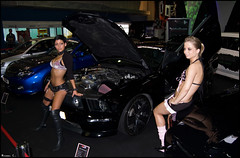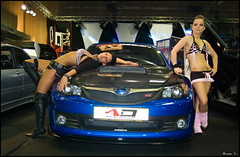Banking on the success of the Leon FR that, last year, was responsible for one in four Leon sales in Britain, Seat introduced a new FR+ derivative, while also extending the FR badge to a broader engine range.
The Leon FR hatch is now available with a 1.4-liter TSI petrol developing 125-horses and linked to a manual transmission only, or a 2.0-liter TDI diesel with 140-horsepower and the choice of either a manual gearbox or a DSG dual clutch automatic transmission.
The FR badge adds new front and rear bumpers, twin chrome exhaust pipe, trademark silver-painted door mirrors, LED rear-light clusters, sports seats and steering wheel, rear parking sensors, rain-sensing wipers, automatic headlights and auto-dimming rear-view mirror.
The previous FR models have been renamed to FR+. Buyers can choose between a 211HP 2.0-liter TSI petrol and a 170HP 2.0-liter TDI CR diesel.
In addition to the FR's standard features, the FR+ trim adds 18-inch ‘Ibera’ alloy wheels; the SEAT Media System 2.2, which includes satellite-navigation with five-inch colour touchscreen, DAB radio, Bluetooth audio streaming and SD card slot; Bluetooth phone connection; Bi-xenon headlights with AFS (Adaptive Front-lighting System) and front parking sensors.
Seat says that while the retail cost of the extra equipment when specified separately is £2,465 RRP, the price of the new Leon FR+ is up by only £1,070 RRP.
Prices for the revised FR lineup start at £18,205 RRP for the Leon FR 1.4 TSI 125 PS, and rise to £22,615 RRP for the Leon FR+ 2.0 TDI CR DSG-auto 170 PS.
Along with the changes to the FR range, Seat also added some new standard features to its flagship 265HP Leon Cupra R model, including a SEAT Media System 2.2, Bluetooth connectivity, Bi-xenon headlights with AFS and LED rear-light clusters.
The additional equipment not only comes at no extra cost, but Seat actually reduced the car's price by £10 to £25,995 RRP.
The Leon FR hatch is now available with a 1.4-liter TSI petrol developing 125-horses and linked to a manual transmission only, or a 2.0-liter TDI diesel with 140-horsepower and the choice of either a manual gearbox or a DSG dual clutch automatic transmission.
The FR badge adds new front and rear bumpers, twin chrome exhaust pipe, trademark silver-painted door mirrors, LED rear-light clusters, sports seats and steering wheel, rear parking sensors, rain-sensing wipers, automatic headlights and auto-dimming rear-view mirror.
The previous FR models have been renamed to FR+. Buyers can choose between a 211HP 2.0-liter TSI petrol and a 170HP 2.0-liter TDI CR diesel.
In addition to the FR's standard features, the FR+ trim adds 18-inch ‘Ibera’ alloy wheels; the SEAT Media System 2.2, which includes satellite-navigation with five-inch colour touchscreen, DAB radio, Bluetooth audio streaming and SD card slot; Bluetooth phone connection; Bi-xenon headlights with AFS (Adaptive Front-lighting System) and front parking sensors.
Seat says that while the retail cost of the extra equipment when specified separately is £2,465 RRP, the price of the new Leon FR+ is up by only £1,070 RRP.
Prices for the revised FR lineup start at £18,205 RRP for the Leon FR 1.4 TSI 125 PS, and rise to £22,615 RRP for the Leon FR+ 2.0 TDI CR DSG-auto 170 PS.
Along with the changes to the FR range, Seat also added some new standard features to its flagship 265HP Leon Cupra R model, including a SEAT Media System 2.2, Bluetooth connectivity, Bi-xenon headlights with AFS and LED rear-light clusters.
The additional equipment not only comes at no extra cost, but Seat actually reduced the car's price by £10 to £25,995 RRP.
PHOTO GALLERY





































